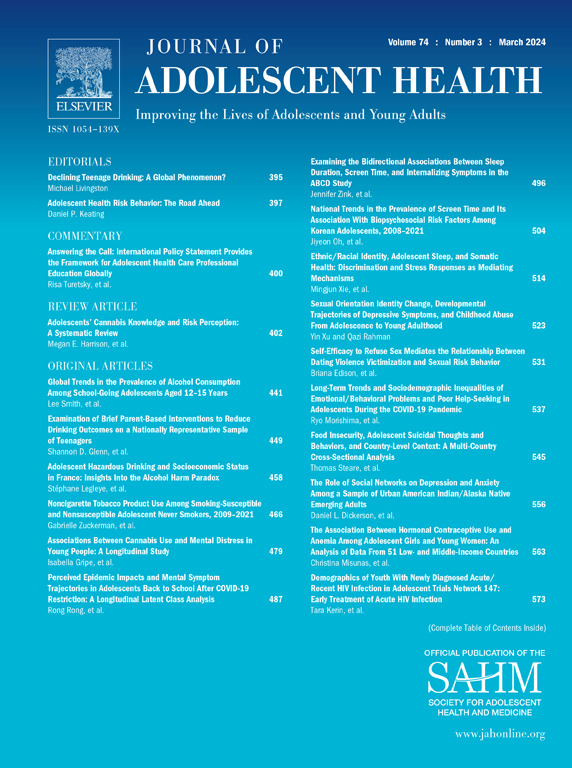Identifying Provider Attitudes, Practices, and Barriers to Extra-Genital Testing for Neisseria Gonorrheae and Chlamydia Trachomatis Infections Among Adolescents and Young Adults
IF 5.5
2区 医学
Q1 PEDIATRICS
引用次数: 0
Abstract
Purpose
Despite increasing rates of Neisseria gonorrheae and Chlamydia trachomatis nationally, prior studies indicate suboptimal screening in pediatric and young adult settings. This study surveyed provider attitudes, knowledge, practices, and barriers around sexually transmitted infection testing to identify potential contributing factors.
Methods
Pediatric providers at a large urban hospital system across different levels of practice and settings completed a survey anonymously via Research Electronic Data Capture. Likert scales and Fisher's exact test were used to quantify and compare provider responses.
Results
Analysis of the 130 respondents indicated discomfort with asking adolescents about their sexual behaviors (61.5% residents vs. 40.0% attendings, p = .002). 50.0% of residents and 73.3% of attendings felt trained to talk about sexual practices (p = .02). Resident (30.8%) and attending (36.0%) physicians were not likely to counsel patients regarding safer sex practices. Attendings (30.8%) and advanced practice providers (48.0%) responded correctly that either providers or patients can self-collect vaginal/rectal and pharyngeal samples. Outpatient and inpatient providers reported some barrier to extra-genital testing, including confidentiality concerns (46.4% and 43.1%, respectively), lack of swabs (41.1% and 31.4%, respectively), and lack of knowledge on performing/ordering the test (57.1% and 49.0%, respectively).
Discussion
Provider discomfort, knowledge and practice gaps, and barriers to extra-genital Neisseria gonorrheae/Chlamydia trachomatis testing were widespread in our study population. Potential targets for improvement include addressing logistic challenges to sample collection, reducing confidentiality concerns, and improving provider training in counseling and clinical decision-making related to adolescent sexual health.
确定提供者的态度,做法,以及青少年和年轻人对淋病奈瑟菌和沙眼衣原体感染进行生殖器外检测的障碍。
目的:尽管淋病奈瑟菌和沙眼衣原体的感染率在全国范围内不断上升,但先前的研究表明,儿科和青壮年群体的筛查效果并不理想。本研究调查了医疗服务提供者对性传播感染检测的态度、知识、实践和障碍,以确定潜在的诱因:方法:一家大型城市医院系统的儿科医疗服务提供者通过研究电子数据采集匿名完成了一项调查,调查涉及不同级别的医疗服务和医疗环境。采用李克特量表和费雪精确检验对医疗服务提供者的回答进行量化和比较:对 130 名受访者进行的分析表明,他们不喜欢询问青少年的性行为(61.5% 的住院医师和 40.0% 的主治医师,P = .002)。50.0%的住院医生和 73.3% 的主治医生认为自己接受过谈论性行为的培训(p = .02)。住院医师(30.8%)和主治医师(36.0%)不太可能就安全性行为为患者提供咨询。主治医师(30.8%)和高级医疗服务提供者(48.0%)正确回答医疗服务提供者或患者可以自行采集阴道/直肠和咽部样本。门诊和住院医疗服务提供者报告了生殖器外检测的一些障碍,包括保密问题(分别为 46.4% 和 43.1%)、缺乏拭子(分别为 41.1% 和 31.4%)以及缺乏进行/订购检测的知识(分别为 57.1% 和 49.0%):讨论:在我们的研究人群中,提供者的不适感、知识和实践差距以及生殖器外淋病奈瑟菌/沙眼衣原体检测的障碍普遍存在。潜在的改进目标包括解决样本采集过程中的后勤问题、减少对保密性的顾虑,以及改善提供者在与青少年性健康相关的咨询和临床决策方面的培训。
本文章由计算机程序翻译,如有差异,请以英文原文为准。
求助全文
约1分钟内获得全文
求助全文
来源期刊

Journal of Adolescent Health
医学-公共卫生、环境卫生与职业卫生
CiteScore
10.40
自引率
3.90%
发文量
526
审稿时长
46 days
期刊介绍:
The Journal of Adolescent Health is a scientific publication dedicated to enhancing the health and well-being of adolescents and young adults. Our Journal covers a broad range of research topics, spanning from the basic biological and behavioral sciences to public health and policy. We welcome a variety of contributions, including original research papers, concise reports, literature reviews, clinical case reports, opinion pieces, and letters to the editor. We encourage professionals from diverse disciplines such as Anthropology, Education, Ethics, Global Health, Health Services Research, Law, Medicine, Mental and Behavioral Health, Nursing, Nutrition, Psychology, Public Health and Policy, Social Work, Sociology, and Youth Development to share their expertise and contribute to our mission of promoting adolescent health. Moreover, we value the voices of young individuals, family and community members, and healthcare professionals, and encourage them to submit poetry, personal narratives, images, and other creative works that provide unique insights into the experiences of adolescents and young adults. By combining scientific peer-reviewed research with creative expressions, our Journal aims to create a comprehensive understanding of the challenges and opportunities in adolescent and young adult health.
 求助内容:
求助内容: 应助结果提醒方式:
应助结果提醒方式:


